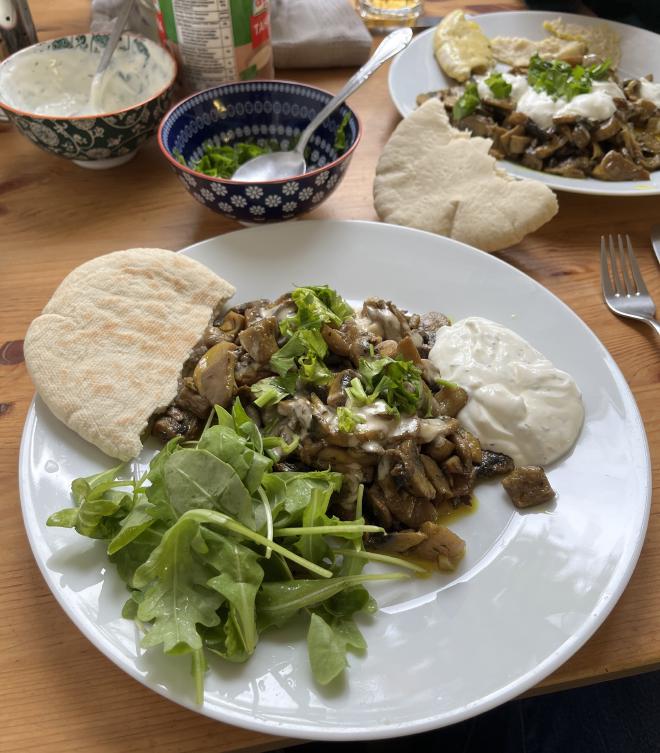Mushroom Shawarma with Tahina Sauce, Tzatziki and Pita
Table of Contents
Jump to Recipe
Jump to Carbon Footprint
Shawarma is usually lamb or beef on a skewer - but this mushroom shawarma is a great meatless alternative that won’t leave you wanting, thanks to the umami in the mushrooms. Serve with pita, slightly bitter tahini and fresh tzatziki.

If you want to serve the shawarma in a pita, you can easily add more vegetables - for example, sliced cucumbers or tomatoes, lettuce or chopped cucumber pickles. Apart from the Greek yoghurt used in the tzatziki, the recipe is completely vegan.
Shawarma is all about the spices and the marinade. If you mix the mushrooms with the marinade the day before and leave it in the fridge overnight before frying, it will be even better. À propos mushrooms: it’s tempting to just use a single pack of mushrooms instead of the colourful mushroom mix, but you’ll miss out on the slightly different flavours and textures that come with the mushroom mix. A simple rule of thumb: at least three types of mushroom!
You need a lot of spices in the marinade to make it tasty and intense. If you feel there’s too much, add a pinch more - you’ll thank yourself.
The recipe originally comes from Haya Molcho’s “Wien by NENI” cookbook (publisher’s website). The recipe calls for the mushrooms to be skewered and then roasted in a frying pan, but if you skip the skewering step and roast everything directly, the result will be just as good.
(And believe it or not, this is the fiftieth recipe to appear on this blog! 🎉 )
Recipe #
Mushroom shawarma with tzatziki, tahini and pita
40 minutes
2 portions
Ingredients #
For the mushroom shawarma
- 4 king oyster mushrooms
- 4 large portobello mushrooms
- 4 large oyster mushrooms
- 3-4 cloves of garlic
- 85 g oil
- 3-5 g salt
- 1-2 g pepper
- 2 teaspoon thyme
- 1 teaspoon paprika powder (smoked)
- Hawaij: 1/2 teaspoon cumin, 1/2 teaspoon cardamom, 1/4 teaspoon turmeric, 1/4 teaspoon pepper, 1/4 teaspoon nutmeg
- as a side dish: 2 pita breads
For the tzatziki
- 1 clove garlic
- about 50 g cucumber
- 150 g Greek yoghurt
- 1/2 teaspoon salt
- 1 teaspoon olive oil
For the tahini
- 5 tablespoons tahini
- 2 tablespoons mango pickles
Directions #
- Clean and chop the mushrooms. (They will lose water and become smaller as they fry.) Peel and chop the garlic. Place the mushrooms in a large bowl or tin with the oil, salt, pepper, thyme, paprika powder and garlic and mix well. (The easiest way to do this in a tin is to put the lid on and shake.) Leave in the fridge for at least half an hour, preferably overnight.
- Make the tzatziki: Peel and dice the garlic, wash and dice the cucumber or grate into fine strips. Mix all the ingredients together, stir well and leave to stand in the fridge.
- Heat a frying pan on the stove at the highest heat, then pour in the mushroom-oil-herb mixture and sear. Reduce the heat slightly and continue to stir the mushroom mixture. It takes about 10 minutes for the water to evaporate from the mushrooms. Continue to fry briefly until the mushrooms develop a toasted flavour.
- While the mushrooms are frying, mix the tahini and mango pickles with a little water in a screw-top jar and shake vigorously to mix everything together.
- Make the Hawaij spice mix by mixing the dry spices together.
- Arrange the mushroom shawarma on a plate, drizzle with a little tahini sauce and sprinkle with a pinch of the Hawaij spice mix. Serve with tzatziki and pita bread and enjoy immediately.
Carbon Footprint #
In total, two portions of mushroom shawarma with tzatziki, tahini and pita have an estimated carbon footprint of 1821 g.
This ranks it number 39 out of 57 recipes published on the blog so far in terms of estimated carbon footprint.
It therefore belongs to the tertile of recipes with the highest emissions (bottom 33%). 😮Looking at the individual ingredients, oil and Greek yoghurt stand out, both of which contribute disproportionately to the carbon footprint: in the case of oil, this is due to the amount of raw materials required to produce one litre of oil. As a result, oil accounts for about 7% of the weight of the ingredients in this recipe, but about 15% of the emissions. In the case of Greek yoghurt, the main cause is methane emitted by cows. As a result, yoghurt accounts for about 13% of the weight of the ingredients, but about a fifth of the greenhouse gas footprint of this recipe. Although the mushrooms themselves make a below-average contribution, they still have a relatively high carbon footprint compared to vegetables: about 1.3 kg of CO2 equivalents are released for 1 kg of mushrooms - but only about 200 g of CO2 equivalents for 1 kg of courgettes.
| ingredient | carbon footprint per kg | carbon footprint (in g) for 2 servings | % of ingredients | % of CO2 emissions |
|---|---|---|---|---|
| Mushrooms (king oyster mushrooms, portobello mushrooms, oyster mushrooms) | 1.3 | 871 | 58% | 48% |
| Garlic | 0.5 | 5 | 1% | 0% |
| Oil | 3.3 | 281 | 7% | 15% |
| Salt | 0.7 | 3 | 0% | 0% |
| Pepper | 1,2 | 2 | 0% | 0% |
| Thyme | 1.1 | 11 | 1% | 1% |
| Paprika powder | 1.1 | 3 | 0% | 0% |
| Hawaij spice mix | 1.1 | 9 | 1% | 0% |
| Pita bread | 0.9 | 77 | 8% | 4% |
| Garlic | 0.5 | 1 | 0% | 0% |
| Cucumber | 0.4 | 20 | 4% | 1% |
| Greek yoghurt | 2.4 | 366 | 13% | 20% |
| Salt | 0.7 | 1 | 0% | 0% |
| Olive oil | 3.2 | 16 | 0% | 1% |
| Tahina | 0.9 | 43 | 4% | 2% |
| Mango pickles | 3.8 | 77 | 2% | 4% |
| Fry mushrooms | 35 | 2% |


